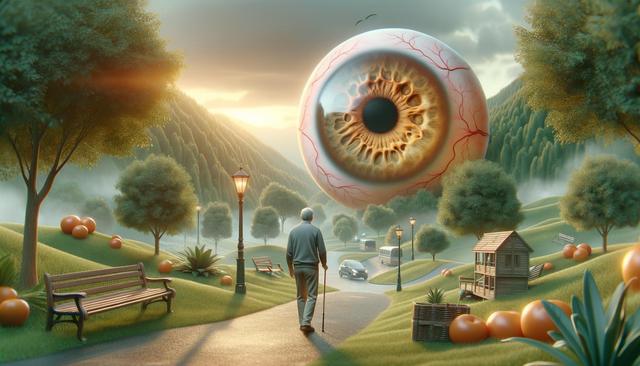2 vitamins that help you with the vision

Understanding Macular Degeneration
Macular degeneration, often referred to as age-related macular degeneration (AMD), is a progressive eye disorder that affects the macula, the small central part of the retina responsible for sharp, straight-ahead vision. This condition is one of the primary causes of vision loss in individuals over the age of 50. There are two main types of AMD: dry and wet. Dry AMD is more common and develops gradually as the macula thins over time. Wet AMD, though less common, is more severe and occurs when abnormal blood vessels grow under the retina and leak fluid or blood, leading to rapid vision loss.
Symptoms of macular degeneration can vary depending on the stage and type of the condition. Common signs include blurry or distorted central vision, difficulty recognizing faces, and trouble reading or seeing fine details. Early detection through routine eye exams is vital, as many patients may not notice symptoms in the early stages. While macular degeneration doesn’t cause complete blindness, it can severely impair central vision, making everyday tasks more challenging.
Risk Factors and Prevention
Several risk factors contribute to the development of macular degeneration. Age is the most significant, with the risk increasing significantly after age 50. Genetics also play a role, particularly if there is a family history of the condition. Lifestyle choices can influence the onset and progression of AMD. For instance, smoking has been strongly linked to an increased risk, as it reduces the amount of oxygen reaching the retina.
Other contributing factors include:
- Obesity and poor diet
- High blood pressure and cardiovascular disease
- Prolonged exposure to ultraviolet light
- Low levels of physical activity
Preventive strategies often focus on lifestyle changes. Quitting smoking, eating a balanced diet rich in leafy greens and colorful fruits, and wearing sunglasses to block UV rays are all beneficial. Regular physical activity and maintaining a healthy weight also help lower the risk of developing AMD or slowing its progression.
The Role of Nutrition in Eye Health
Nutrition plays a key role in preserving eye health and potentially slowing the progression of macular degeneration. Research has shown that certain nutrients are particularly beneficial for the retina. Two vitamins that help with vision and may support macular health are vitamin C and vitamin E. These antioxidants protect the eyes from oxidative stress, which is a contributing factor in retinal damage.
Other important nutrients include:
- Lutein and zeaxanthin – found in green leafy vegetables
- Zinc – essential for the proper functioning of retinal enzymes
- Omega-3 fatty acids – support overall eye health and may reduce inflammation
Including these nutrients in one’s diet can be achieved through natural food sources or supplements. However, it’s important to consult with a healthcare provider before starting any new supplementation, especially for those with underlying health conditions or taking medications.
Treatment Options and Management
While there is currently no cure for macular degeneration, several treatment options are available to manage the condition and slow its progression. For dry AMD, the focus is largely on monitoring and nutritional intervention. In some cases, an eye specialist may recommend a specific formulation of vitamins and minerals known as the AREDS2 formula, which has shown promise in reducing the risk of advanced AMD in some individuals.
For wet AMD, more active interventions are available:
- Anti-VEGF injections – help reduce the growth of abnormal blood vessels
- Photodynamic therapy – uses a light-activated drug to target abnormal vessels
- Laser therapy – less commonly used but may be suitable for certain patients
Ongoing monitoring through regular eye exams is essential. Low vision aids and rehabilitation services can also help individuals adapt to changes in their vision and maintain independence in daily activities.
Living With Macular Degeneration
Adjusting to life with macular degeneration can be challenging, but many tools and strategies can help maintain quality of life. Early diagnosis and intervention are crucial to preserving as much vision as possible. People with AMD can benefit from working with low vision specialists who can recommend adaptive devices, such as magnifiers, special lighting, and electronic reading aids.
Practical tips for living with AMD include:
- Using large-print books and high-contrast labels
- Implementing better lighting throughout the home
- Organizing items consistently to reduce reliance on vision
- Exploring smartphone apps designed for low vision users
Emotional support is also important. Vision changes can lead to frustration, anxiety, or depression. Support groups, counseling, and occupational therapy can provide valuable assistance. Family members and caregivers should be educated about the condition to offer effective support and encouragement.
Conclusion: Supporting Eye Health Through Awareness and Action
Macular degeneration is a condition that requires ongoing attention, proactive care, and informed lifestyle choices. Understanding the risk factors, recognizing symptoms early, and taking preventive steps such as incorporating vision-supporting vitamins like vitamin C and vitamin E can make a meaningful difference. While the condition can impact daily life, many individuals continue to lead active and fulfilling lives by utilizing available treatments and support systems. Staying informed, attending regular eye exams, and making vision health a priority are key steps in managing macular degeneration effectively.
